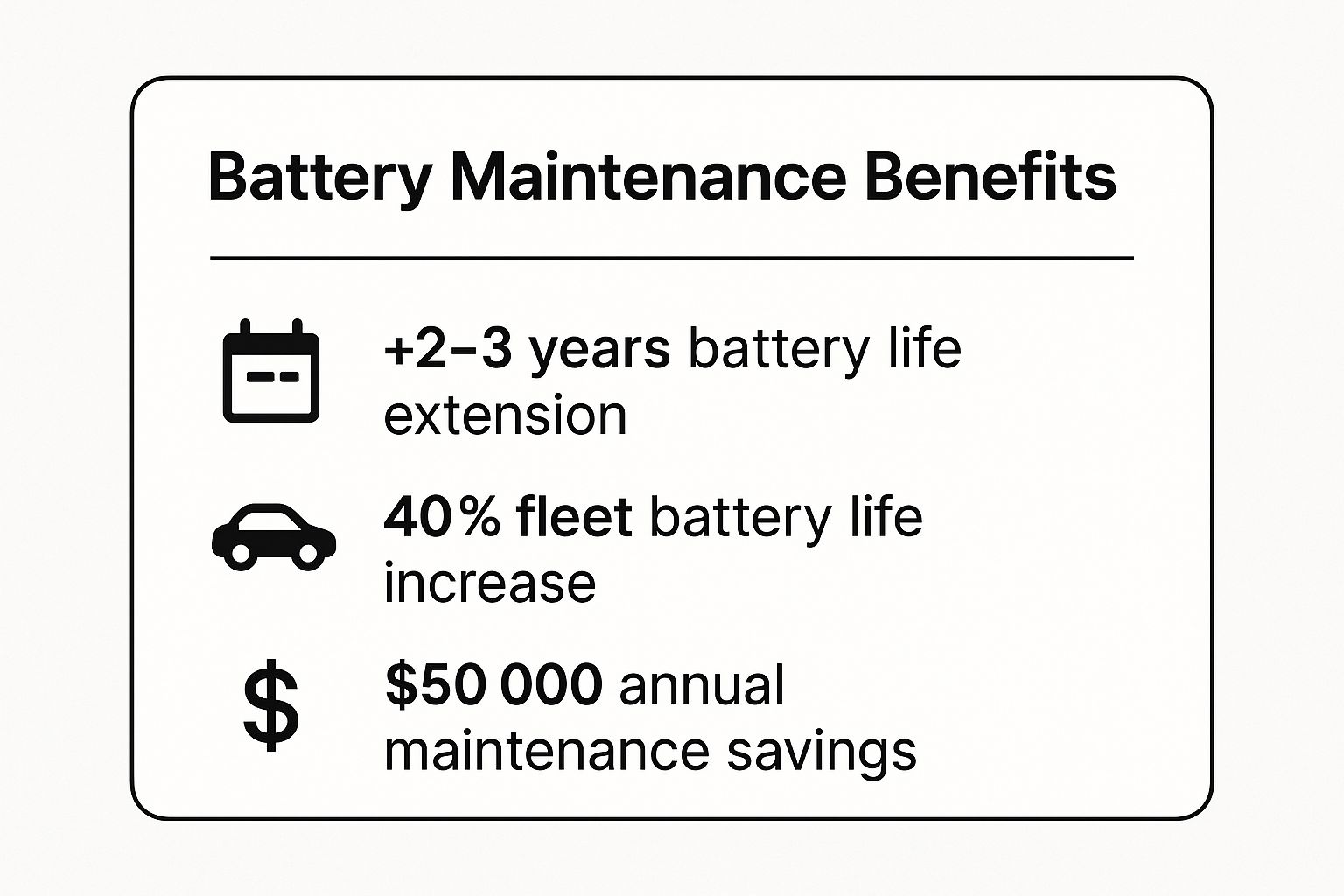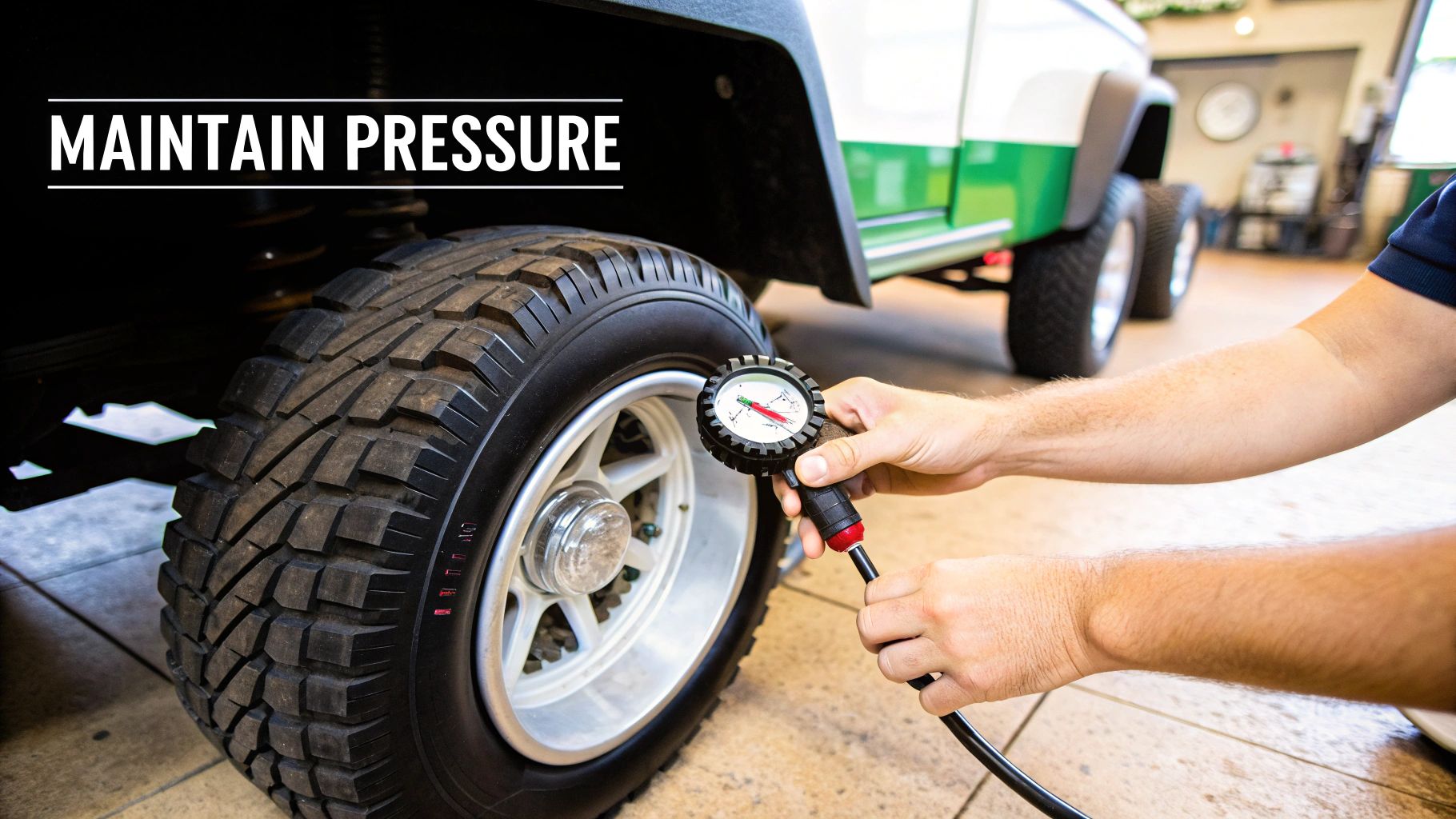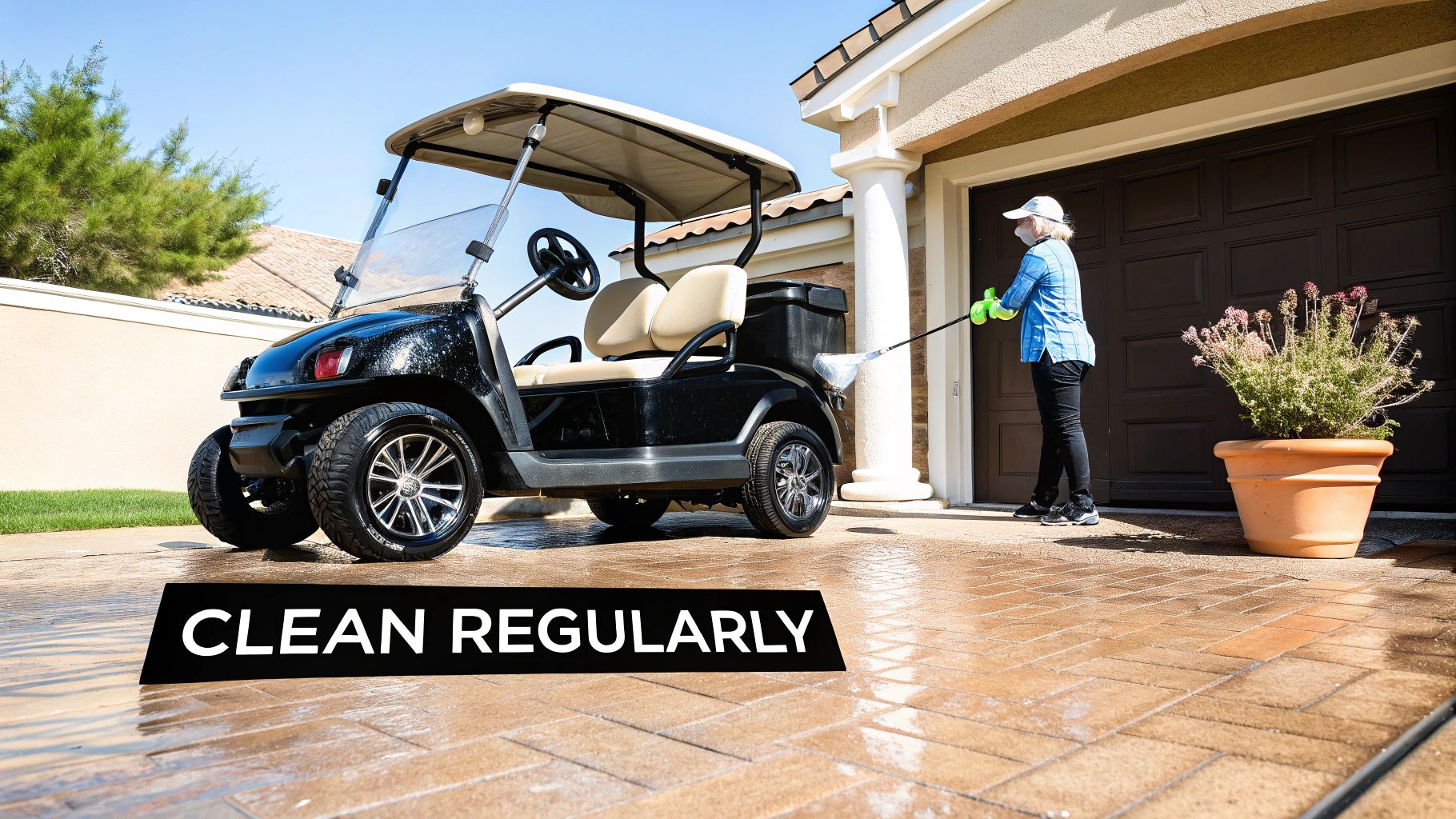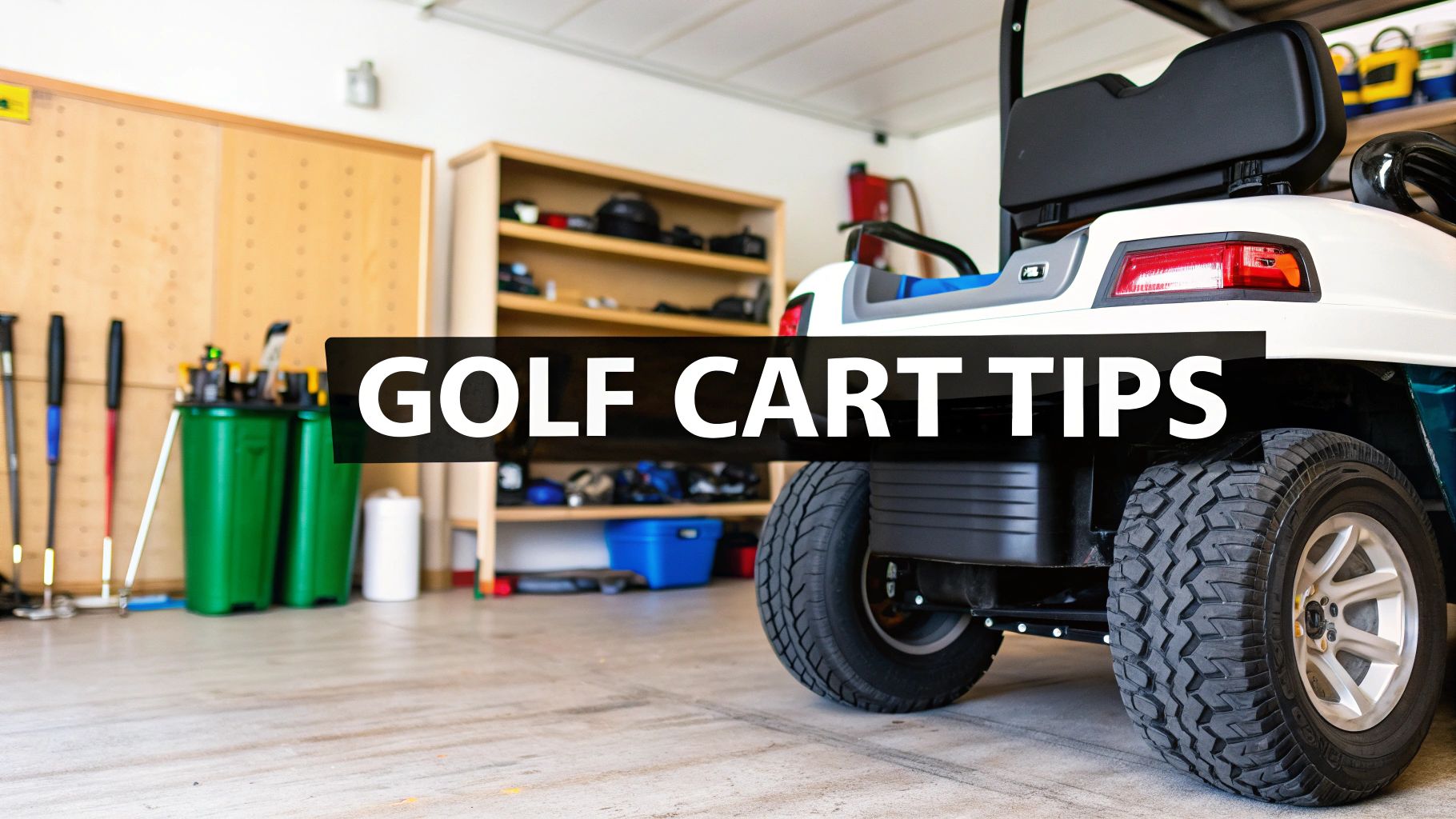A well-maintained golf cart is more than just transportation; it's a reliable partner for every round, a key to course enjoyment, and a significant investment worth protecting. Neglecting basic upkeep can lead to frustrating breakdowns, costly repairs, and a drastically shortened lifespan for your vehicle. This guide moves beyond generic advice to provide detailed, actionable golf cart maintenance tips that both new and experienced owners can implement immediately.
We will cover the most critical systems to ensure your cart runs smoothly and safely. You will learn the specific procedures for:
- Proper battery care to maximize power and longevity.
- Tire and tread inspection to prevent flats and ensure stability.
- Brake system checks for reliable stopping power.
- Effective cleaning routines to fight corrosion.
- Lubricating key parts to reduce wear and tear.
- Inspecting drive belts to avoid unexpected failures.
By following these essential routines, you can ensure your golf cart operates efficiently and dependably for years to come. Let's dive into the checks that will keep your ride in pristine condition, ready for the fairway whenever you are.
1. Battery Maintenance and Care: The Heartbeat of Your Cart
For any electric golf cart, the battery pack is its most critical and expensive component. Proper care is the single most important aspect of any golf cart maintenance routine, directly impacting the cart's power, range, and operational lifespan. Neglecting the battery is a surefire way to face a hefty replacement bill sooner than necessary.
Think of battery maintenance not as a chore, but as a proactive health and wellness plan for your cart's power source. Major fleet operators have proven the financial and operational benefits of such a regimen. For example, Club Car's ProGuard maintenance programs have demonstrated an ability to extend fleet battery life by as much as 40%. Similarly, a case study at the renowned Pinehurst Resort revealed that implementing a systematic battery care protocol saved the facility over $50,000 annually in replacement and labor costs.
This infographic summarizes the significant returns you can expect from a consistent battery care routine.

The data clearly shows that a small investment of time in maintenance yields substantial long-term benefits, from extending battery life by years to delivering significant cost savings.
Actionable Battery Care Tips
To achieve these results, integrate these specific golf cart maintenance tips into your regular schedule:
- Charge After Every Use: Never let your cart sit in a discharged state. Plug it in after every single use, no matter how short the drive. This practice, recommended by industry leaders like the Trojan Battery Company, prevents sulfate crystal buildup that permanently degrades battery capacity.
- Use Distilled Water Only: For lead-acid batteries, check water levels monthly during peak season. When topping off, only use distilled water. Tap water contains minerals that will coat the internal lead plates, insulating them and effectively destroying the battery over time.
- Neutralize Corrosion: Once a month, inspect the battery terminals for corrosive buildup (a white or bluish powder). Clean them with a paste made from baking soda and water, using a wire brush to scrub the terminals and cable ends.
- Ensure Tight Connections: After cleaning, re-secure the cable connectors and torque them to the manufacturer's specifications. Loose connections create resistance, generating heat that can melt terminals and starve your motor of power.
For a visual guide on these essential steps, the video below offers a great walkthrough.
By following this proactive approach, you ensure your cart is always ready to perform at its best. To dive deeper, you can explore this comprehensive guide to golf cart battery maintenance on CaddieWheel.com.
2. Tire Pressure and Tread Inspection: The Foundation of Safety and Efficiency
Often overlooked, your golf cart's tires are the only point of contact with the ground, making their condition crucial for safety, performance, and efficiency. Proper tire care is a fundamental part of any golf cart maintenance tips checklist. It directly influences everything from ride comfort and steering control to battery consumption and the longevity of the tires themselves. Ignoring tire health can lead to poor handling, increased strain on the drivetrain, and even dangerous blowouts.

Treating tire maintenance as a priority pays significant dividends, a lesson learned by top-tier golf resorts. For instance, Pebble Beach was able to achieve an impressive 40% longer tire lifespan across its fleet simply by implementing weekly pressure checks. Similarly, other resort courses have reported a 50% reduction in tire-related breakdowns and service calls by adopting a proactive maintenance schedule. These examples underscore the direct financial and operational benefits of this simple yet effective practice.
This consistent attention to detail ensures every cart operates safely and efficiently, protecting both the passengers and the turf.
Actionable Tire Care Tips
To maximize the life and performance of your tires, integrate these specific maintenance habits into your routine:
- Check Pressure Regularly: Using a quality tire pressure gauge, check each tire at least once a month and always before an extended period of use. Consistent pressure is key. Underinflated tires cause excessive friction, which drains your battery faster and leads to premature wear on the tire's edges.
- Maintain Manufacturer-Recommended PSI: Most standard golf cart tires are designed to be inflated to a pressure between 18 and 22 PSI (pounds per square inch). Always consult your tire's sidewall or your cart's manual for the exact specification. Augusta National famously maintains 22 PSI in its fleet carts for optimal turf protection and performance.
- Inspect for Damage and Wear: Before each ride, perform a quick visual inspection. Look for embedded nails, screws, glass shards, or any cuts and bulges in the sidewall. Uneven wear patterns can indicate an alignment problem that needs to be addressed.
- Rotate Tires for Even Wear: To ensure your tires wear down evenly, rotate them every 6-12 months or every 50-100 hours of use. A common pattern is to move the front tires to the back and the back tires to the front on the same side.
- Know When to Replace: The legal minimum tread depth for road tires is 2/32 of an inch. While most golf carts stay off-road, this is a good safety benchmark. You can use a penny to check: if you can see all of Abraham Lincoln's head when inserted into the tread, it's time for a new set of tires.
For more information on tire specifications and care, the Carlisle Tire maintenance protocols offer an industry-standard resource that many fleet managers follow. Following these golf cart maintenance tips will keep your cart rolling smoothly and safely for years.
3. Brake System Inspection and Adjustment
While batteries provide the "go," the brake system delivers the essential "stop." Ensuring your golf cart's brakes are in perfect working order is not just a matter of performance; it's a fundamental aspect of safety for you, your passengers, and everyone around you. Neglecting this critical system can lead to dangerous situations and costly repairs, making regular inspection a non-negotiable part of your golf cart maintenance tips.
Think of brake maintenance as the seatbelt of your golf cart's care plan. The proactive safety benefits are well-documented by major manufacturers and fleet operators. For instance, following Yamaha's recommended brake maintenance schedule has been shown to prevent up to 95% of potential brake failures in their carts. Similarly, country club fleets that implement quarterly inspections often report zero brake-related safety incidents, highlighting the effectiveness of a simple, consistent check-up routine.
For a clearer picture, consider the operational impact. Golf cart rental companies have demonstrated that by following proper maintenance protocols, they can extend the life of brake components by as much as 60%. This not only enhances safety but also translates directly into significant savings on parts and labor over the vehicle's lifespan.
Actionable Brake System Tips
To ensure your cart stops safely and reliably every time, integrate these specific brake system checks into your regular schedule:
- Test Brakes Before Each Use: Make it a habit to perform a quick brake test before you begin any trip. Simply press the pedal to feel for proper engagement and resistance. It should not feel spongy, nor should it travel all the way to the floor.
- Adjust Brake Cables Regularly: Over time, brake cables can stretch. If your brake pedal's travel exceeds 1.5 to 2 inches before the brakes engage, it's time for an adjustment. This process, outlined in your owner's manual, ensures the brakes activate promptly.
- Inspect and Replace Brake Shoes: Periodically, you will need to inspect the brake shoes for wear. Once the friction material is worn down to approximately 1/8 inch thickness, they must be replaced to maintain adequate stopping power.
- Clean Brake Components: At least monthly, especially in dusty or muddy conditions, clean the brake assemblies. Use a brake cleaner spray to remove dirt, dust, and grime that can impede performance and accelerate wear.
- Service Hydraulic Brakes Annually: If your cart is equipped with hydraulic brakes, it's crucial to have the brake fluid flushed and replaced annually by a qualified technician. Old fluid can absorb moisture, leading to corrosion and reduced braking effectiveness.
For a detailed visual walkthrough on adjusting mechanical brakes, the video below provides an excellent step-by-step guide.
By making these checks a routine part of your golf cart maintenance, you guarantee a safer ride and prevent the most common brake-related issues. For more detailed instructions specific to your model, refer to the brake maintenance section on Golf Cart Garage.
4. Cleaning and Washing Routine
A systematic cleaning routine is far more than just maintaining your cart's appearance; it's a fundamental part of preventative maintenance. Regular washing prevents the long-term damage caused by dirt, grime, salt, and acidic contaminants. It protects the cart's body, frame, and components from corrosion and deterioration, directly preserving its resale value and operational integrity.
This infographic summarizes the significant returns you can expect from a consistent cleaning routine.

Think of cleaning as an active inspection. Luxury resort fleets, which maintain a like-new appearance even after five years of heavy use, rely on weekly cleaning protocols to spot issues early. This proactive approach allows maintenance teams to identify loose bolts, fluid leaks, or early signs of wear before they become significant problems. Data from private owners supports this, showing that carts with a well-documented cleaning history can command up to 30% higher resale values. Similarly, some fleet operators have reported a 20% reduction in overall maintenance costs by integrating inspections into their washing schedule.
Actionable Cleaning Tips
To protect your investment and keep your cart in top condition, incorporate these golf cart maintenance tips into a regular cleaning schedule:
- Use Proper Cleaners: Always opt for automotive-grade, pH-balanced soaps. Household detergents are often too harsh and can strip away wax and protective coatings, leaving the finish vulnerable to UV damage and oxidation. Brands like Chemical Guys offer specialized cart cleaning products designed for this purpose.
- Protect Electrical Components: Before washing, take care to protect sensitive electrical parts. Use plastic bags or wraps to cover the controller, motor, charger port, and ignition switch. Avoid using a high-pressure washer directly on these areas, as forceful water can penetrate seals and cause costly damage.
- Clean the Undercarriage: At least once a month, thoroughly clean the cart's undercarriage. This area collects corrosive elements like fertilizer, pesticides, and road salt. A clean undercarriage prevents rust and allows you to easily inspect the frame, suspension, and steering components.
- Apply UV Protection: After washing and drying, apply a quality UV protectant to all plastic, vinyl, and rubber surfaces, including the dashboard, seats, and tires. This step prevents cracking, fading, and discoloration caused by sun exposure.
- Inspect as You Clean: Turn your cleaning time into a detailed inspection. As you wipe down each section, check for loose hardware, cracked body panels, unusual wear on tires, and any signs of fluid leaks. This habit is one of the most effective ways to catch minor issues before they escalate.
For a great visual on proper cleaning techniques, the video below provides a detailed demonstration.
By integrating these steps, you not only enhance your cart's aesthetic appeal but also significantly extend its lifespan and reliability. To learn more about advanced detailing, you can find helpful guides on detailing forums like Autogeek.
5. Lubrication of Moving Parts: Ensuring a Smooth and Silent Ride
Just as your body's joints need to stay flexible, your golf cart's moving parts require proper lubrication to function smoothly and prevent premature wear. This crucial step in your golf cart maintenance routine reduces friction, minimizes squeaks and groans, and ensures the steering, suspension, and pedal linkages operate as intended. Neglecting lubrication leads to stiff steering, a rough ride, and costly repairs down the line.
Think of lubrication as a protective barrier against the constant stress of movement and environmental exposure. Fleet managers and service technicians understand its immense value. For instance, manufacturer maintenance schedules, like those from EZGO, have shown that consistent lubrication can extend the life of critical steering components by as much as 75%. Similarly, golf course maintenance crews often report a 50% reduction in suspension-related repairs on carts that receive regular, preventive lubrication.
This proactive care translates directly into savings and better performance. Fleet operators following professional maintenance standards save thousands of dollars annually, not just on parts but also on the labor required to fix issues caused by excessive friction and wear.
Actionable Lubrication Tips
To keep your cart running smoothly and quietly, integrate these specific lubrication tips into your maintenance schedule:
- Follow Manufacturer Recommendations: Always use the specific type of grease or oil recommended in your cart's service manual. Different components, like those in products from Lucas Oil or specified in Yamaha's protocols, have different needs; using the wrong lubricant can be ineffective or even cause damage.
- Grease Key Fittings Seasonally: At least once per season, use a grease gun to apply automotive grease to all zerk fittings. These are typically found on suspension components (like leaf spring shackles and A-arms) and steering parts (like the steering box and tie-rod ends).
- Lubricate Steering and Pedal Linkages: Every few months, apply a light penetrating oil or spray lubricant to the pivot points in the accelerator and brake pedal assemblies. Also, apply it to the steering column shaft and any universal joints to ensure responsive control.
- Keep a Maintenance Log: Track when you lubricate each part of your cart. A simple log helps you stay on schedule and ensures no component is missed, which is a core principle of professional fleet maintenance.
A well-lubricated cart is not only more reliable but also more enjoyable to drive. If you find you need specialized lubricants or a new grease gun, you can find a list of trusted suppliers when you read more about the best golf cart accessories retailers on CaddieWheel.com.
6. Belt and Drive System Maintenance
For gas-powered golf carts, the drive system, comprised of the drive belt and clutches, is what translates engine power into forward motion. This system is the mechanical equivalent of an electric cart's power controller and motor wiring. Neglecting the belt and clutches is a direct path to getting stranded on the course with a cart that runs but won't move, often leading to complex and expensive repairs.
Think of the drive belt as the crucial link in your cart's powertrain. Proper maintenance ensures this link remains strong, delivering smooth acceleration and reliable performance. Fleet maintenance protocols, like those developed by Yamaha and Club Car, place a heavy emphasis on drive system inspections. For example, golf course fleets have demonstrated an 80% reduction in drive system failures by implementing regular inspection schedules. Similarly, Yamaha G-series carts are known to achieve over 3,000 operational hours on their original clutches when proper belt maintenance prevents excessive wear and heat.
These proactive checks are essential golf cart maintenance tips that prevent the common issue of a shredded belt, which can damage the clutches and leave you immobile. A small amount of preventative attention saves significant time, money, and frustration down the line.
Actionable Belt and Drive System Tips
To ensure your drive system remains in top condition, incorporate these specific maintenance tasks into your routine:
- Check Belt Tension and Condition Monthly: The drive belt should have a specific amount of slack, typically around 1/2 to 3/4 inch of deflection when pressed. A belt that is too tight strains engine bearings, while one that is too loose will slip and burn. Inspect the belt for cracks, glazing (a shiny, smooth surface), fraying, or missing sections.
- Replace Worn Belts Promptly: Don't wait for a belt to fail completely. If it shows any of the signs of wear mentioned above, replace it. A proactive replacement costs very little compared to the potential damage from a snapped belt.
- Clean Clutches During Replacement: When you replace the belt, take the opportunity to clean the clutch sheaves (the pulley surfaces) with a dry cloth or compressed air. Removing belt dust and grime ensures the new belt grips properly for optimal power transfer.
- Verify Proper Alignment: Ensure the drive and driven clutches are perfectly aligned. Misalignment will cause the belt to wear out on one side very quickly and can lead to performance issues.
- Keep a Spare: A drive belt is one of the most critical and easy-to-carry spare parts. Keeping a new, correct-sized belt in your cart's storage compartment can turn a day-ending breakdown into a minor, 15-minute fix.
While this section focuses on riding carts, understanding powertrain efficiency is key for all golf equipment. For those considering an alternative way to get around the course, you can explore this guide to choosing the right golf push cart at CaddieWheel.com.
6-Key Golf Cart Maintenance Tips Comparison
| Maintenance Aspect | Implementation Complexity 🔄 | Resource Requirements ⚡ | Expected Outcomes ⭐📊 | Ideal Use Cases 💡 | Key Advantages ⭐ |
|---|---|---|---|---|---|
| Battery Maintenance and Care | Moderate – requires safety precautions and regular monitoring | Requires battery charger, distilled water, cleaning supplies | Extends battery life by 2-3 years; maintains power and reliability | Electric golf carts relying on lead-acid batteries | Longer battery life; prevents costly replacements; improved reliability |
| Tire Pressure and Tread Inspection | Low to Moderate – simple tools needed, regular checks mandatory | Pressure gauge, lifting equipment for rotation (optional) | Extends tire life by 25-30%; improves battery efficiency and safety | All golf carts operating frequently in various conditions | Improves safety and ride comfort; reduces rolling resistance |
| Brake System Inspection and Adjustment | Moderate to High – mechanical knowledge recommended | Basic brake tools, possible professional service | Prevents accidents; extends brake life; avoids costly repairs | Safety-critical; carts in heavy use or passenger transport | Ensures safe stopping power; reduces risk of failure |
| Cleaning and Washing Routine | Low to Moderate – time-intensive, attention to care | Cleaning supplies, water, wax/sealant products | Preserves appearance; prevents corrosion; early problem detection | Carts exposed to environmental elements and frequent use | Maintains resale value; protects components; promotes ownership pride |
| Lubrication of Moving Parts | Moderate – requires knowledge of points and lubricants | Lubricants (grease, oil), maintenance tools | Extends life of steering and suspension parts; reduces noise | Carts with mechanical steering and suspension systems | Prevents wear; ensures smooth operation; reduces repair needs |
| Belt and Drive System Maintenance | Moderate to High – mechanical skill needed; partial disassembly possible | Inspection tools, replacement belts/clutches | Reduces breakdowns; improves power transmission efficiency | High-hour usage carts or demanding terrain | Prolongs belt life; ensures consistent performance; prevents failures |
Your Roadmap to a Long-Lasting, Reliable Golf Cart
Navigating the landscape of golf cart ownership doesn't have to be complex or costly. The journey from being a reactive owner dealing with unexpected breakdowns to a proactive caretaker ensuring peak performance is built on a foundation of consistent, simple actions. By integrating the six core pillars of maintenance discussed in this guide, you are essentially creating a powerful insurance policy for your investment. This isn't about becoming a master mechanic overnight; it's about embracing a routine that saves you money, prevents frustration, and guarantees your cart is always ready for your next tee time.
Think of each of these golf cart maintenance tips not as a chore, but as a small, strategic step towards long-term reliability. Diligent battery care is the heartbeat of your cart’s performance, while proper tire pressure and brake inspections form the backbone of its safety and efficiency. These aren't isolated tasks but interconnected systems. A clean, well-lubricated cart runs smoother, putting less strain on the drive system and battery, ultimately extending the life of every component.
From Knowledge to Action: Your Maintenance Game Plan
The true value of these insights lies in their application. To transform this knowledge into tangible results, consider creating a simple, personalized maintenance schedule. You can use a physical checklist in your garage or a digital reminder on your phone.
Your action plan could look something like this:
- After Every Use: A quick wipe-down and visual check for any immediate issues.
- Monthly Checks: A dedicated time to inspect tire pressure, test the brakes, check battery water levels (for lead-acid types), and look for any signs of wear on belts.
- Seasonal Deep Dive: Before storing for winter or at the start of the golf season, perform a thorough cleaning, lubricate all moving parts, and conduct a more detailed inspection of the entire system.
This structured approach removes the guesswork and turns essential upkeep into a manageable habit.
Key Takeaway: Proactive maintenance is not about adding another task to your to-do list. It's about investing a few minutes each month to safeguard your freedom on the course, protect your wallet from costly emergency repairs, and maximize the enjoyment you get from your golf cart.
By mastering these fundamental golf cart maintenance tips, you ensure that your vehicle remains a dependable asset, not a recurring liability. This commitment to care allows you to focus on what truly matters: enjoying a smooth, worry-free round of golf, every single time.
Ready to enjoy the benefits of a powered round without the extensive maintenance of a full-sized golf cart? The Caddie Wheel transforms your existing push cart into a motorized caddie, letting you walk the course effortlessly. Discover how to upgrade your game at the official Caddie Wheel website.


Share:
Golf Cart Battery Replacement Cost Guide
7 Unmissable Benefits of Walking Golf Course in 2025